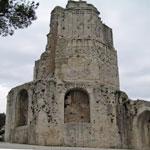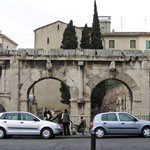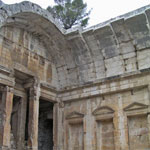
Named for a local Celtic spring deity, Nemausus (Nîmes) stood at the convergence of a number of important routes. Strictly speaking, it is part of Languedoc, not Provence. It was an important pre-Roman town; its inhabitants traded with Greeks from Massalia. In the late second century B.C., it became a Roman military outpost, expanding as a Roman military colony (colonia latina) and commercial center under Julius Caesar and later under Augustus in the first century B.C. After the battle of Actium in 31 B.C. Augustus settled many of his troops here and at least three major public works were dedicated to him: the Maison Carrée, the nymphaeum, and the fortifications that measured more than six kilometers in length and enclosed an area of about 550 acres. Other large buildings were soon added--the Pont du Gard brought water into the city from springs near Uzès; the amphitheater provided public entertainment; and there were probably public baths and other urban amenities. The emperor Trajan's wife Plotina was apparently born here and the second century emperors Hadrian and Antoninus Pius also favored it. The town declined following the end of Roman rule, beginning under the Visigoths in the fifth century. One of its claims to fame today is as the original source of denim or cloth de Nîmes. Walking around the modern town one can see a number of well-preserved and familiar Roman building types such as the amphitheater and temple (Maison Carrée) as well as some less-familiar urban building types, also in a good state of preservation (the castellum or terminus of the aqueduct from Uzès; Tour Magne or fortification tower; "Temple of Diana"--really a library; and the Porte d'Auguste or a formal gate through the Roman fortifications).
 Amphitheater |
 Castellum & Tour Magne |
 Gate of Augustus |
 Jardin de la Fontaine |
 Maison Carée |
Advertisement

Advertisement







